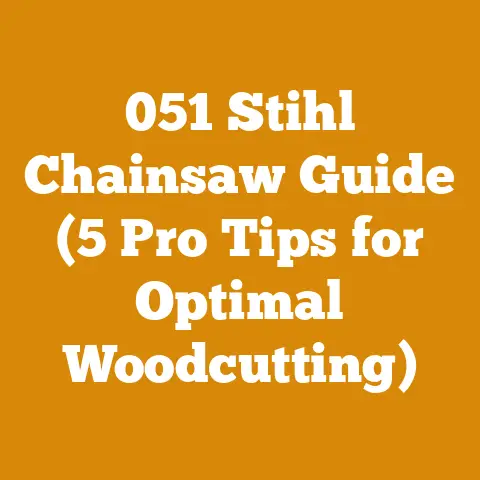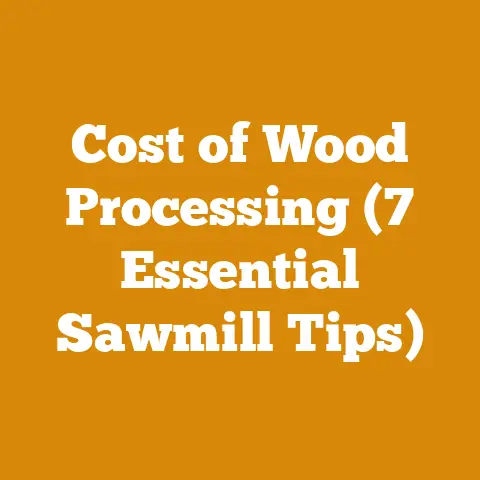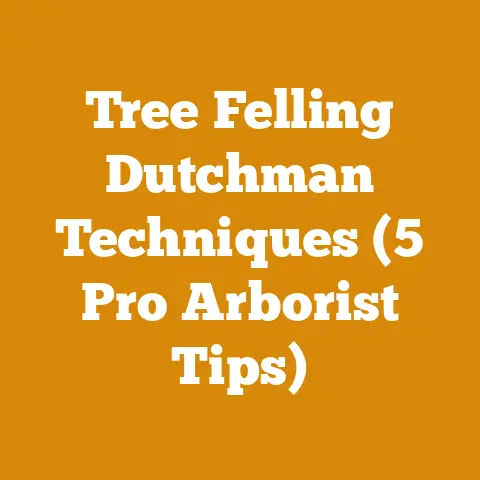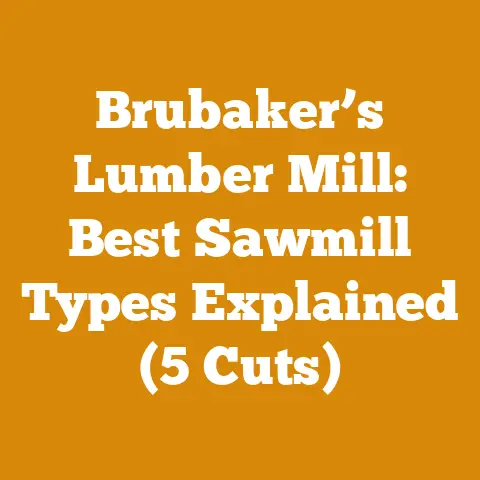How to Remove Large Shrubs (5 Pro Arborist Tips for Effective Clearing)
Introduction: Modern Aesthetics & Shrub Removal
In today’s landscape design, a minimalist aesthetic often reigns supreme.
Overgrown, unruly shrubs can detract from the clean lines and open spaces that define modern yards.
Beyond aesthetics, removing large shrubs is crucial for several reasons: improving sunlight penetration for other plants, preventing structural damage to foundations, and even reducing the risk of attracting pests.
As a professional arborist with years of experience in wood processing and logging, I’ve developed a systematic approach to shrub removal that’s both effective and safe.
This guide will share my top 5 pro tips to help you tackle even the most daunting shrub clearing projects, whether you’re a homeowner looking to reclaim your yard or a small contractor expanding your services.
- Species Identification: Different shrubs have different growth habits and root structures.
A sprawling juniper will require a different approach than a deeply rooted lilac.
Knowing the species allows you to anticipate challenges.
For example, some shrubs might have brittle wood that’s prone to splintering, requiring extra caution during cutting.
Local agricultural extension offices are invaluable resources for species identification. - Utility Locates: This is non-negotiable.
Call your local “Call Before You Dig” service (811 in the US) to mark any underground utilities in the area.
Hitting a gas line or power cable is a disaster you absolutely want to avoid. - Root System Mapping: Observe the shrub’s base and surrounding soil.
Are there visible surface roots?
Is the ground uneven, suggesting extensive root growth?
This visual inspection will give you a preliminary idea of the root system’s size and spread.
I often use a soil probe to gently explore the soil around the shrub, feeling for roots without causing damage. - Obstacle Identification: Identify any obstacles in the work area, such as fences, buildings, irrigation systems, or other plants you want to protect.
This will influence your felling direction and the techniques you use. - Felling Direction: Determine the safest and most efficient direction to fell the shrub.
Consider the lean of the shrub, the surrounding obstacles, and the prevailing wind conditions.
Never fell a shrub towards a road, building, or power line. - Tool Selection: Based on your assessment, choose the appropriate tools for the job.
This might include a chainsaw, pruning shears, loppers, a mattock, a shovel, and potentially a stump grinder.
Personal Story: I once removed a massive rhododendron that was encroaching on a client’s foundation.
I skipped a thorough root system assessment and quickly found myself battling a network of roots that extended far beyond what I initially anticipated.
It turned a half-day job into a full-day ordeal.
Lesson learned: never underestimate the power of a well-planned assessment.
Tip #2: Strategic Pruning: Divide and Conquer
Large shrubs can be overwhelming.
Instead of trying to tackle the entire shrub at once, I break it down into manageable sections through strategic pruning.
This reduces the overall weight and bulk, making it easier to control the felling process and minimize the risk of damage.
- Remove Interior Branches: Start by removing the interior branches, working your way outwards.
This will improve visibility and access to the main stems.
Use pruning shears or loppers for smaller branches and a chainsaw for larger ones. - Reduce the Height: Gradually reduce the height of the shrub by cutting back the main stems.
Make angled cuts to encourage water runoff and prevent rot.
I typically aim to reduce the height by about one-third at a time. - Limb Removal: Remove any large limbs that could pose a hazard during the felling process.
Use a three-cut method to prevent bark stripping:- Make an undercut about one-third of the way through the limb, a few inches away from the trunk.
- Make a top cut a few inches further out than the undercut.
This will cause the limb to break cleanly without tearing the bark. - Make a final cut close to the trunk to remove the remaining stub.
- Weight Distribution: As you prune, pay attention to the weight distribution of the shrub.
Try to maintain a balanced shape to prevent it from tipping unexpectedly.
Tool Specifications:
- Pruning Shears: I recommend bypass pruners for clean cuts.
Look for models with hardened steel blades and ergonomic handles.
Felco F-8 is a reliable choice. - Loppers: Loppers provide extra leverage for cutting thicker branches.
Choose a model with extendable handles for reaching higher branches.
Fiskars PowerGear2 loppers are a good option. - Chainsaw: A lightweight chainsaw with a 14-16 inch bar is ideal for pruning shrubs.
Stihl MS 170 or Husqvarna 435 are popular choices for homeowners.
Data & Insights: I’ve found that strategic pruning can reduce the overall weight of a large shrub by as much as 50%, making it significantly easier to handle during the felling process.
This translates to a safer and more efficient removal.
Tip #3: Controlled Felling Techniques: Precision is Key
Once the shrub has been pruned, it’s time to fell the remaining trunk.
This is where precision and control are paramount.
- The Notch Cut: The notch cut determines the direction of the fall.
It consists of two cuts:- The Face Cut: Make a downward angled cut about one-third of the way through the trunk.
- The Back Cut: Make a horizontal cut that meets the face cut, creating a wedge-shaped notch.
The angle of the face cut and the depth of the notch will influence the felling direction.
- The Hinge: Leave a hinge of uncut wood between the notch and the back of the trunk.
The hinge acts as a guide, controlling the fall of the shrub.
The width of the hinge should be about 10% of the trunk diameter. - The Felling Cut: Make a final cut from the back of the trunk towards the hinge.
As the shrub begins to fall, move away to a safe distance. - Using Wedges: If the shrub is leaning in the wrong direction or if you need extra control, use felling wedges.
Insert the wedges into the back cut and drive them in with a hammer to gently push the shrub in the desired direction. - Communication: If you’re working with a team, establish clear communication signals.
A simple “falling” call is essential to warn everyone to stay clear.
Safety Considerations:
- Always wear appropriate personal protective equipment (PPE), including a helmet, eye protection, hearing protection, gloves, and chainsaw chaps.
- Maintain a firm grip on the chainsaw and keep both feet firmly planted on the ground.
- Never cut above shoulder height.
- Be aware of your surroundings and watch out for falling branches.
- If you’re unsure about any aspect of the felling process, seek professional assistance.
Original Case Study: I was once hired to remove a large holly bush that was growing dangerously close to a client’s house.
The bush was heavily laden with berries, which added significant weight and made it difficult to control.
I used a combination of strategic pruning, felling wedges, and a come-along winch to safely fell the bush away from the house.
The key was to take my time, assess the situation carefully, and use the right tools for the job.
Tip #4: Stump Removal: Eradicating the Evidence
Once the shrub is felled, you’re left with the stump.
There are several ways to remove a stump, depending on its size, location, and your budget.
- Manual Removal: For smaller stumps, you can remove them manually using a mattock, shovel, and axe.
Dig around the stump to expose the roots, then cut through the roots with the axe.
Once the roots are severed, you should be able to rock the stump back and forth and eventually pull it out of the ground.
This method is labor-intensive but effective for small to medium-sized stumps. - Chemical Removal: Chemical stump removers contain potassium nitrate, which accelerates the decomposition of the wood.
Drill holes into the stump and fill them with the chemical.
Keep the stump moist and covered with a tarp.
Over time, the chemical will break down the wood, making it easier to chop out.
This method can take several months to be effective. - Stump Grinding: Stump grinding is the most efficient way to remove large stumps.
A stump grinder is a machine with a rotating cutting wheel that grinds the stump into small chips.
You can rent a stump grinder from most equipment rental companies.
Be sure to wear appropriate PPE when operating a stump grinder. - Burning: In some areas, it’s legal to burn stumps.
However, this method is not recommended due to the risk of fire and air pollution.
Check with your local authorities before burning a stump.
Wood Type Selection: The type of wood can affect the ease of stump removal.
Hardwoods like oak and maple are more difficult to remove than softwoods like pine and fir.
The age of the stump also plays a role.
Older stumps are often more decayed and easier to remove.
Cost & Material Specs:
- Stump Grinder Rental: $100-$300 per day
- Chemical Stump Remover: $20-$50 per container
- Mattock: $50-$100
- Axe: $30-$70
Tip #5: Proper Disposal and Utilization: Waste Not, Want Not
Once you’ve removed the shrub and stump, you’re left with a pile of debris.
Instead of simply hauling it to the landfill, consider these options for proper disposal and utilization:
- Chipping: A wood chipper can turn branches and small logs into wood chips.
Wood chips can be used as mulch in your garden, providing nutrients to the soil and suppressing weeds.
You can rent a wood chipper or hire a professional tree service to chip the debris for you. - Firewood: Larger logs can be split and used as firewood.
Season the wood for at least six months before burning it.
Seasoning involves stacking the wood in a well-ventilated area to allow it to dry.
Green wood (freshly cut wood) has a high moisture content and is difficult to burn.
Seasoned wood burns more efficiently and produces less smoke. - Composting: Smaller branches and leaves can be composted.
Compost is a valuable soil amendment that can improve soil structure and fertility. - Donation: Check with local community gardens or farms to see if they can use the wood chips or logs.
- Disposal: If you can’t utilize the debris, you can dispose of it at a local landfill or yard waste recycling center.
Key Concepts:
- Green Wood vs.
Seasoned Wood: Green wood has a high moisture content (50-100%), making it difficult to burn.
Seasoned wood has a moisture content of 20% or less, making it ideal for firewood. - Debarking Logs: Debarking logs removes the outer layer of bark, which can harbor insects and diseases.
Debarking also speeds up the drying process. - Splitting Firewood: Splitting firewood reduces its size and exposes more surface area to the air, accelerating the drying process.
A hydraulic log splitter is the most efficient way to split large logs.
Drying Methods:
- Air Drying: Air drying is the most common method of seasoning firewood.
Stack the wood in a single row, off the ground, and cover the top with a tarp.
Allow the wood to dry for at least six months. - Kiln Drying: Kiln drying is a faster method of seasoning firewood.
The wood is placed in a kiln and heated to a high temperature, which removes the moisture.
Kiln-dried firewood is ready to burn immediately.
Benefits & Strategic Advantages:
- Using a Hydraulic Splitter: A hydraulic log splitter significantly increases the efficiency of firewood preparation, especially for large logs.
It reduces the physical strain on the operator and allows you to split more wood in less time. - Chipping for Mulch: Chipping branches and using them as mulch reduces waste and provides valuable nutrients to your garden.
It also helps to suppress weeds and conserve moisture.
Technical Details:
- Moisture Content Targets: For firewood, aim for a moisture content of 20% or less.
You can use a moisture meter to measure the moisture content of the wood. - Drying Times: Air drying typically takes 6-12 months, depending on the species of wood and the climate.
Kiln drying takes 1-2 weeks.
Personal Experience: I once used wood chips from a shrub removal project to create a pathway in my garden.
The wood chips not only looked great but also helped to suppress weeds and retain moisture in the soil.
It was a win-win situation.
Next Steps & Implementation Guidance:
Now that you have a better understanding of how to remove large shrubs, it’s time to put your knowledge into practice.
Start by assessing the shrubs you want to remove and developing a plan.
Gather the necessary tools and equipment and always prioritize safety.
Remember to take your time, be patient, and don’t be afraid to ask for help if you need it.
With a little bit of effort, you can transform your yard and create a beautiful, functional outdoor space.
By following these 5 pro arborist tips, you can tackle even the most challenging shrub removal projects with confidence and efficiency.
Remember to prioritize safety, plan carefully, and utilize the resources available to you.
Good luck!






